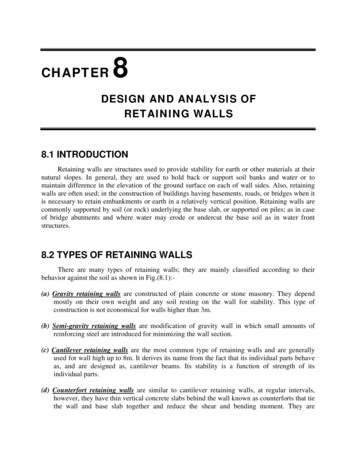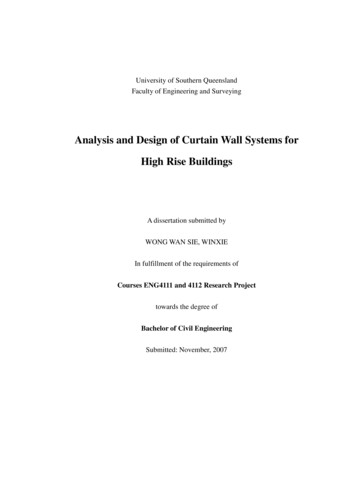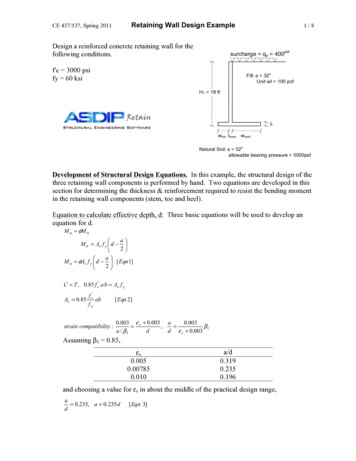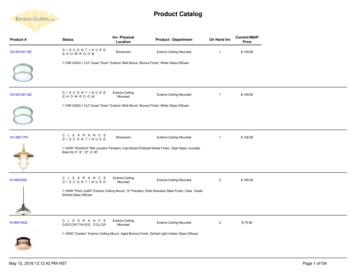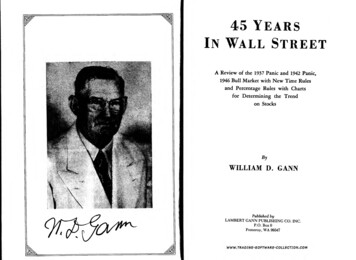
Transcription
45 YearsIn Wall StreetA Review of the 1937 Panic and 1942 Panic,1946 Bull Market with New Time Rulesand Percentage Rules with Chartsfor Determining the Trendon StocksByWILLIAM D. GANNPublished byLAMBERT GANN PUBLISHING CO. INC.P.O. Box 0Pomeroy, WA 99347WWW. TRADING’SOFT WAR (' 'COLLECT] ON .COM
FOREWORDIn 1910 at the request of friends I wrote a small bookletentitled “Speculation a Profitable Profession.” In this book let I gave the rules that helped me to make a success in mypersonal trading.January, 1923, I wrote, “Truth of the Stock Tape” tohelp those who were trying to help themselves in speculationand investment trading. This book was favorably receivedby the public and many proclaimed it my Masterpiece. Thebook fulfilled its mission as evidenced by letters from grate ful readers. After predicting the great panic in 1929 therewas a call for a new book to bring “Truth of the Stock Tape”up to date. I answered that call in the early part of 1930by writing “Wall Street Stock Selector” giving my readersthe benefit of practical experience in which I developed newrules since 1923. In “Wall Street Stock Selector” I pre dicted the “Investors Panic,” and said that it would be thegreatest panic the world had ever known. This predictionwas fulfilled by the panic which ended in July, 1932, withsome stocks declining to the lowest levels they had reachedfor the past 40 to 50 years.A great advance followed the 1932 panic and my ruleshelped many people to make substantial profits.In 1935 satisfied readers asked me to write a new book.I responded to that call by writing my third book “NewStock Trend Detector” in the latter part of 1935, giving thebenefit of my experience and new and practical rules whichI had discovered.Since 1935 many changes have taken place; the marketpassed through the panic of 1937 which was forecast by me.The decline ended in March, 1928, and a minor Bull Marketfollowed to November 10, 1938.The second World War started September 1/1939, andthe United States entered the war in December, 1941. Afterwe were in the war a further liquidation in stocks occurredand final lows were reached April 28, 1942, when stocks soldbelow the low level of ,1938 at the lowest levels since 1932.From the lows in 1942 a prolonged advance followed
which continued after the end of the Japanese War inAugust, 1945.1946, May 29, stocks sold at the highest level they hadreached since 1929. My rules and my forecast called thetop of this advance and the sharp decline which followed toOctober 30, 1946, when final low was reached.Fourteen years have passed since writing my last book andI- have gained more knowledge through actual market opera tions.The world is tipset and confused; investors andtraders are puzzled over the business depression and the de cline in the stock market. Many have written requesting meto write a new book. With the desire to help others I havewritten “45 Years in Wall Street” giving the benefit of myexperience and my new discoveries to aid others in thesedifficult times. I am now in my 72nd year; fame would dome no good. I have more income than I can spend for myneeds, therefore, my only object in writing this new book isto give to others the most valuable gift possible—KNOWL EDGE! If a few find the way to make safer investments myobject will have been accomplished and satisfied readerswill be my reward.W. D. Gann.July 2,1949INTRODUCTIONIn 1926 I read “Truth of the Stock Tape,” written byW. D. Gann in 1923. To me it was a masterpiece. Then in1927 I met Mr. Gann and since then I have read all thebooks he has written. The rules he has laid down havegreatly benefited me when times were good, also when theywere trying.In one place he says “Remember when you make a trade,you can be wrong, therefore place a stop loss order for yourprotection.” Another rule says, “When in doubt, get out ofthe market.Then again he says, “When you have nothingbut hope to hold on to, get out of the market.” That I amwriting this, should indicate I have followed these rules andothers in his books, and they have paid off.It has been my pleasure and privilege to read Mr. Gann’slatest book, “Forty-Five Years in Wall Street,” before itgoes to press, and I commend it to others. What he haswritten here is the result of many years of research andstudy. He is the only man I ever knew who I thought hadworked as much as Mr. Thomas Edison.In this his latest book, the rule on short time periodprice correction is a valuable one to any investor. Timeperiod rules, three day and nine point charts and anniversarydates, are new discoveries by Mr. Gann, that I have neverread about from anyone else.This book contains rules that will help one make profitsand keep them, if the rules are learned and applied withouthope or fear.Clarence Kirven.July, 1949
45 YEARSmWALL STREETCONTENTSCHAPTERPAGEI. Is It More Difficult to Make Profits NowThan Before 1932?.1Why You Have Lost Money in Stocks and How toMake it Back.4II. Rules for Trading in Stocks.624 Never Failing Rules.16III. How to Select Independent Movers.27Buying one Stock and Selling Another Short. 27IV. Percentage of High and Low Prices.30Market Action Proves the Rules.33Present Position of Dow Jones 30 Industrial Averages. 37Let the Market Tell its own Story.38V. Time Periods of Short Duration Correct Prices. 39Liquidation after a Long Decline and a ShortRally in a Bear Market.44Final Liquidation in Great Bear Market. 46Secondary Decline after September 8 High. 46Secondary Rally.47Sharp Corrective Declines.48Final High in the Bull Market.49Secondary Rally in Bear Market.49Final Liquidation in the Bear Market.50End of Short Bull Market.50Sharp Decline and Clean Out.51War Moves.51Final Lows End of Bear Market.52Final Tops End of Bull Market.53Secondary Decline.54After Election, Sharp Quick Declines.55VI. Time Periods for Important Swings on the Averages.57VII. Dow Jones 30 Industrial Averages 3-Day Chart Moves.609-Point Swings Dow Jones 30 Industrial Averages.7530-Point Moves.80VIII. Months when Extreme Highs and Lows were Recorded.Mopthly High and Low Prices Each Year.Dow Jones 30 Industrial Averages Time Swings.828588
CONTENTS (Continued)PACECHAPTERIX. June Lows Comparison for Future HighsAnniversary Dates.Important News Events.Resistance Levels 128-130.Resistance Levels 193-196.Resistance Levels 158-163.909294949597. .99X. Volume of Stock Sales on New York Stock Exchange.104105106.108.XIII. New Discoveries and InventionsAtomic Power.114115XIV. Great Market Operators of the Past.116XV. Stocks Liquidated.123XVI. Can United States Afford Another War?The Government Cannot Prevent a DepressionWhat Will Cause the Next Depression or Panic?Great Panic Coming—Future Trend of StocksOutlook for 1950.Preview of 1951-53.Conclusion.126129129130131132133XI. 15 Public Utility Averages.Barron’s Air Transport Averages.Stocks with Small Number of Shares.XII. Puts, Calls, Rights and Warrants on StocksAnswers to Inquiries.- . 147-149CHARTS1. Dow Jones 30 Industrial Averages 3-Day Chart A1342. Dow Jones 30 Industrial Averages 3-Day Chart B1353. 6ow Jones 30 Industrial Averages 3-Day Chart C1364. Dow Jones 30 Industrial Averages 9-Point Chart 11375. Dow Jones 30 Industrial Averages 9-Point Chart 21386. Dow Jones 30 Industrial Averages 9-Point Chart 31397. Dow Jones 30 Industrial Averages 9-Point Chart 41408. Barron’s Air Transport Averages Monthly1419. Dow Jones 15 Public Utility Averages A14210. Dow Jones 15 Public Utility Averages B14311. Electric Bond and Share Monthly.14412. Pan American World Airways Monthly14513. Radio146CorporationQuarterly.45 YEARSIN WALL STREETCHAPTERIIS IT MORE DIFFICULT TO MAKE PROFITS NOWTHAN BEFORE 1932?Many people write me and ask this question. My answeris—No, you can make just as great profits now as you evercould, provided you select the right stocks to buy and sell.Changed conditions have changed market actions somewhat.The laws passed by the government regulate trading instocks and require higher margin. The income tax lawsmake it necessary to trade for the long pull swings in orderto escape paying too much income tax. It no longer pays totry to scalp the market because swings in a short period oftime do not warrant it. Remaining in the broker’s office andtrying to read the tape is out of date. You will benefit byspending your time making up charts and studying them.Many stocks that have been listed for a long time havebecome seasoned and move more slowly. This cuts out thepossibilities for quick profits in a short period of time. Thereis no longer a large list of stocks selling at high prices above 100 per share and making wide fluctuations.1949, June 14, when stocks reached extreme Low therewere about 1,100 issues traded in that day. There wereonly 112 stocks selling above 100 per share. Many ofthese were preferred stocks held by investors and this classof stocks moves in a narrow range. On June 14 there were315 stocks selling below 20, 202 selling below 10, and 83selling below 5.00 per share, making a total of 600 selling-l—W W W, JRA 01NG-S 0 FTWA R E - COU CTJ 0 N, C 0 MWWW, TRA 0ING -SOFTWARE' CPU EOT] ON,COM
below 20 per share, or more than 50 (/c of the total issuestraded. With so many stocks selling at Low Levels, you canonly make money by taking a long-pull trading position.During recent years many *bf the high priced stocks havedeclared stock dividends, splitting up the stock and puttingmore stocks in the low price range.Larger Profits on Same Amount of CapitalYou can make more money today than you could severalyears ago using the same amount of capital. For example:When a stock was selling at 100 per share and you bought100 shares you had to put up 10,000 or pay for it outright.And at the time you could buy it on the 50(/c margin, if itadvanced 10 points, you made a profit of 1,000 or 20/con your capital. At the present time, suppose you shouldbuy 1,000 shares of a stock selling at 10 per share on a509c margin, this would require 5,000 capital.If thestock advances 5 points you will have made a profit of 5,000or 100/r on your capital investment. With so many stocksselling at Low Levels with good prospects for future en hancement, you have opportunities for making profits just asfast today as ever before.Volume of Sales SmallerThe total volume of stocks traded on the New YorkStock Exchange during recent years is much smaller. Thisis because people buy stocks and hold them longer. Thereare no longer any pools or manipulation in stocks since thepassing of the Security Exchange Regulations. This doesnot mean that there cannot be Big Bull markets and largeadvances in the future. As time goes by stocks pass into thehands of investors who hold them for a long period of time.The floating supply is gradually absorbed.Then, whensomething suddenly happens to start a buying wave, buyersfind the supply of stocks scarce and have to bid them up.It always happens that the higher prices go, the more peoplewant to buy. This causes a final grand rush and a rapidadvance in the last stages of a Bull Market. History re peats on Wall Street and what has happened in the past will2——happen again in the future.In January, 1946, the U. S. Government made a rulecompelling everyone who bought stocks to put up 1009cmargin, or in other words, pay for them outright. Stockswere already selling at very High Levels and had been ad vancing for three and a half years. Did this ruling by thegovernment stop the public from buying stocks? It did not.The Averages advanoed more than 20 points and the advancelasted five months longer to May 29, 1946, when final Highwas reached, which proves that the government could notstop the advance in stocks as long as the people were in themood to buy. In fact, a lot of traders believe that thegovernment took this action because it thought there wouldbe a runaway advance in stocks and traders believing thiscontinued to buy stocks regardless of the margin required.My experience has taught me that nothing can stop the Trendas long as the Time Cycle shows Up-Trend. Nothing can stopits decline as long as the Time Cycle shows Down. Stockscan and do go Up on bad news and go Down on good news.1949 in March, the government reduced the marginal re quirements on stock to 50 9 margin. Many people thoughtthis was very bullish and that it would start a Bull Market,but it did not. Stocks rallied for two days to March 30,then declined over 18 points on the Averages until June 14.They went down because the Trend was down. The TimeCycle had not run out for Bottom,Cross Currents in StocksIn recent years the market has been more mixed than fora long time. Some groups of stocks advance while othersdecline at the same time. This is due to various causes aridconditions in the different industries. You can determinethese cross currents and get the Trend of any individual stockif you keep up a Monthly High and Low Chart and studyit and apply the rules which I give you.3——
Why You Have Lost Money in StocksANDHow to Make It BackWhy do the great majority of people who buy and sellstocks lose?There are three main reasons:1. They overtrade or buy and sell too much for theircapital.2. They do not place stop loss orders or limit their losses.3. Lack of Knowledge.be able to act with confidence and make profits when voucan SEE and KNOW for YOURSELF why STOCKS shouldgo UP or DOWN.That is why you should study all of my rules and make upcharts for yourself on the individual stocks, as well as theaverages. If you do this you will prepare yourself to actindependent of the advice of others, because you will knowfrom Time-Tested Rules what the trend of the market shouldbe.This is the most importantreason of all.Most people buy a stock because they hope it will go upand they will make profits. They buy on tips, or whatsomeone else thinks, without any concrete knowledge of theirown that the stock will advance. Thus they entered themarket wrong and did not recognize this mistake or attemptto correct it until too late. Finally they sell because theyfear the stock will go lower and often they sell out near lowlevels, getting out at the wrong time, making two mistakes,getting in the market at the wrong time and getting out atthe wrong time. One mistake could have been prevented,they could have gotten out right after getting in wrong.They do not realize that operating in Stocks and Commoditiesis a business or a profession, the same as engineering or themedical profession.Why You Should Learn to Determine the Trend of the MarketYou may have tried to follow market letters and like manyothers either lost money or failed to make profits, becausethe market letters gave a list of too many stocks to buy orsell and you picked the wrong one and lost. A smart mancannot follow another man blindly even though the otherman is right, because you cannot have confidence and act onadvice when you do not know what it is based on. You will4——WWW, TRAOING'SQFTWARB’COLLBCTION.COMWWW,TRADWG- OFTWAR 'CQUECTIQN,COM
Rule 1. Determining the TrendCHAPTERIIRULES FOR TRADING IN STOCKSTo make a success in trading in stocks you must get theknowledge first; you must learn before you lose.Manytraders go into the stock market without any knowledge andlose a large pact of their capital before they learn that it isnecessary to go through a period of preparation before theystart trading. I am giving you the benefit of more than 45years of experience in the stock market and laying downrules which, if you learn and follow, will make you a success.The first thing for you to realize is that when you makea trade you can be wrong; then you must know what to do tocorrect your mistake. The way to do that is to limit yourrisk by placing a Stop Loss Order 1, 2 or 3 points below theprice at which you buy. Then if you are wrong you willautomatically be sold out and will be in position to enter themarket again when you have a definite indication. Do notguess; make a trade on definite rules and according to definiteindications based on the rules which I lay down; this will giveyou a better chance to make a success.Read all of the rules and examples in my books, “Truth ofthe Stock Tape”, “Wall Street Stock Selector” and “NewStock Trend Detector”, and study 12 and 24 rules which arebound with this book “45 Years in Wall Street’. The rulesare good and will benefit you if you study them. Rememberthat you can never learn too much. Always be ready andwilling to learn something new; never have a fixed idea thatyou know it all. If you do, you will not make any moreprogress. Times and conditions change and you must learnto change with them. Human nature does not change andthat is the reason history repeats and stocks act very muchthe same under certain conditions year after year and in thevarious cycles of time.Determine the trend of the Dow-Jones 30 IndustrialAverages or the 15 public utilities averages or the averageon any group of stocks that you intend to trade in, then selectthe stock in the group in which you want to trade and see ifits Trend indications conform to the Trend indicated by theAverages. You should use the 3-Day Chart for the Averagesand the 9-Point Average Swing Chart as outlined later inthe book, and apply all of the rules for determining the righttime to buy or sell.Rule 2. Buy at Single, Double and Triple BottomsBuy at Double and Triple Bottoms or on Single Bottomswhen they are nearer previous Old Bottoms or Tops or re sistance levels. Remember the rule: Tops or ceilings whichare selling points become floors, supports or buying pointsafter these tops have been crossed and the market reacts tothem, or sells slightly below them. Sell at or against Single,Double or Triple Tops and, remember, that after an Old Topis broken by several points and the market rallies up to ornear it again, it becomes a selling point. After you havemade a trade, determine the proper and safe place to place aStop Loss Order, and give it to your broker immediately.If you do not know where to place a Stop Loss Order, do notmake the trade.Do not overlook the fact that the 4th time the averagesor an individual stock reaches the same level it is not as safeto sell, because it nearly always goes through. Reverse thisrule at the bottom. When stocks decline to the same levelthe 4th time in most cases it breaks the bottom and con tinues down.The Meaning of Double Tops and BottomsA Double Top on the Averages can be in a range of 3 to5 points. However, most Double Tops form in a range offrom 1 to 2 points except at great extremes. The same wayat an extreme bottom. If there has been a previous bottom6——7——
around this same level many years back, the Averages candecline 4 to 5 points below the previous bottom withoutindicating that th y are going lower, and this can become aDouble or a Triple Bottom.Individual stocks usually make a Double Top in a 2 to 3point range and sometimes within a 1 to 2 point range. Thesame at the bottom; they make a Double Bottom in a 2 to 3point range and sometimes the range is only 1 to 2 pointsbelow the different bottoms. Stop Loss Orders should beplaced on individual stocks 1 to 3 points above Double andTriple Tops, depending upon how high stocks are selling.Stop Loss Orders should be placed under Double and Triple6 to 7 weeks which will be a buying or selling level, pro tected, of course, with Stop Loss Orders according to re sistance levels. After a market rallies or declines more than45 to 49 days, the next time period is around 60 to 65 dayswhich is about the greatest average time that a Bear Marketrallies or a Bull Market reacts.Rule 5. Market Moves in SectionsBottoms 1 to 3 points away.A Triple Top or Bottom occurs when the Averages or anindividual stock has reached the same level the 3rd time.This is often the safest place to buy or sell because the marketmoves away from a Triple Top or a Triple Bottom muchStock market campaigns move in 3 to 4 Sections or waves.Never consider that the market has reached final top whenit makes the first section in a move up, because if it is a realBull Market it will run at least 3 Sections and possibly 4before a final high is reached.In a Bear Market, or declining market, never consider themarket as final bottom when it makes the first decline orSection because it will run 3 and possibly 4 Sections beforethe Bear campaign is over.faster.Rule 6. Buy or Sell on 5 to 7 Point MovesRule 3. Buy and Sell on PercentagesBuy or sell individual stocks on reactions of 5 to 7 points.When a market is strong, reactions will run 5 to 7 points but—will not decline as much as 9 or 10 points. By studying theIndustrial Averages you will see how often a rally or reactionruns less than 10 points. However, it is important to watch10 to 12 point rallies or declines for buying or selling levelson the average. The next important point to watch is 18 to21 points up or down from any important Top or Bottom.Reactions of this kind in the Averages often indicate the endof a move.When to Take Profits—After you have bought stocks orsold them, the next thing you need to know is when to takeprofit. Follow the rules and do not take profits until thereis a definite indication of a change in trend.Buy or sell on a 50% decline from any high level or a50 % advance from any low level so long as these reactions orrallies are with the main trend. You can use the percentageof the individual stocks as well as the percentage of theAverages to determine the resistance levels and buying andselling points. You can use 3 to 5 per cent, next 10 to 12per cent, next 20 to 25 per cent, 33 to 37 per cent, 45 to 50per cent, 62 to 67 per cent, 72 to 78 per cent and 85 to 87per cent. The most important resistance levels are 50% and100% and the proportionate parts of 100%. (See e'xamplesunder Chapter on Percentages of High and Low Prices.)Rule Jf. Buy and Sell on 3 Weeks' Advance or DeclineBuy on a 3 weeks’ reaction or decline in a Bull Marketwhen the main trend is up, as this is the average reaction ina strong Bull Market. In a Bear Market sell on a rally ofaround 3 weeks after you know the trend is down.After a market advances or declines 30 days or more,the next time period to watch for tops and bottoms is aroundRule 7.Volume of SalesStudy the total volume of sales on the New York StockExchange in connection with the time periods and study therules under volume of sales later on in the book. Study the9——
WWW.TRADING-SOFTWARE-CQLLECTIQN'COMvolume of sales on individual stocks based on the rules given,as the volume of sales will help in determining when thetrend is changing.Rule 8. Time PeriodsThe time factor and time periods are most important indetermining a change in trend because Time can over balancePrice and when the Time is up the Volume of sales will increase and force prices higher or lower.Dates for Change in Trend—The stock market averagesand individual stocks follow a seasonal change in trend whichvaries in different years, but by knowing the important datesand watching them you will be able to determine a change mtrend very quickly by applying all the other rules. The im portant dates are as follows:January 7 to 10, and 19 to 24. These are the most im portant at the beginning of the year, and changes in trend thatlast for several weeks, and sometimes several months, occuraround these dates. Check the records and prove it foryourselfFebruary 3 to 10, and 20 to 25.These are next importantto the dates in January.,March 20 to 27. Minor changes occur around this dateand sometimes major tops or bottoms occur.April 7 to 12, and 20 to 25. Not as important as Januaryand February, but the latter part of April is often quite im portant for a change in trend.May 3 to 10, and 21 to 28. The changes this month areof as great importance as those that occur in January andFebruary, and many major Tops and Bottoms have occurredaround these dates in the past and a change in trend hastaken place. .jJune 10 to 15, and 21 to 27. Minor changes in trendoccur around these dates and in some years extreme highs andextreme lows occur. Example: 1948, June 14, extreme high;1949, June 14, extreme low, up to the time of this writing.July 7 to 10, 21 to 27. This month is next in importanceto January because it is at the middle of the year when10——dividend payments occur and seasonal changes and crop con ditions have some effect on the change in trend of stocks.August 5 to 8, and 14 to 20. This month is as importantin some ways as February for change. Check the backrecords and you will see how important changes occur aroundthese dates.September 3 to 10, and 21 to 28. These periods are themost important of any in the year, especially for Tops, or finalhighs in a Bull Market, as more highs have occurred inSeptember than any other month. Some minor changes, bothup and down, have occurred around these dates.October 7 to 14, and 21 to 30. These periods are quiteimportant and some major changes have occurred betweenthese dates. They should always be watched if a market hasbeen declining or advancing for some time.November 5 to 10, and 20 to 30. These are very im portant for changes in trend as a study in past history willprove. In election years a change in trend often occurs inthe early part of the month, and in other years low pricesare recorded between the 20th and 30th.December 3 to 10, and 15 to 24. The latter period andrunning into the January period for a change in trend hasshown a high percentage of changes over a period of years.Refer to the 3-day chart tables showing exact dates whenextreme high and low price has been reached and check thesepast dates and watch them each month in the future.When looking up dates for Change in Trend, considerwhether the market has run from any high or low price 7 to12 days, 18 to 21, 28 to 31, 42 to 49, 57 to 65, 85 to 92,112 to 120, 150 to 157, or 175 to 185 days. The more im portant the top and bottom that these Time periods startfrom, the more important the change.Market Over-Balanced—The Averages or individualstocks become over-balanced after they have advanced ordeclined a considerable period of Time, and the greater theTime period, the greater the correction or reaction. Whena Time period on a decline exceeds the Time period of aprevious decline it indicates a change in trend. When the11——
price breaks a greater number of points than the previousdecline or reaction it indicates that the market is OverBalanced and a change in trend is taking place.Reverse this rule in a Bear Market. When stocks havebeen declining for a long period of Time, the first time thata rally exceeds the Time period of a previous rally it is anindication that the trend is changing, at least temporarily.The first time that the price rallies a greater number of pointsthan a previous rally, it indicates that the Space or Price move ment is Over-Balanced and a change in trend has started. TheTime change is more important than reversal in price. Applyall of the rules to see if a change in trend is due at the Timewhen these reversals take place.When the market is nearing the end of a long upswingor a long downswing and reaches the 3rd or 4th Section, theswings upward will be smaller in price gains and the Timeperiod will be less than the previous Section. This is anindication that a change in trend is due. In a Bear or de clining market, when the loss in points becomes less than theprevious Section and the Time period is less, it is an indica tion that the Time cycle is running out.Rule 9. Buy on Higher Tops and BottomsBuy when the market is making higher Tops and higherBottoms which shows that the main trend is up. Sell whenthe market is making lower Tops and lower Bottoms whichindicates the main trend is down. Time periods are alwaysimportant. Check the Time period from previous Top toTop and from previous Bottom to Bottom. Also check theTime required for the market to move up from extreme lowto extreme high and the Time required for prices to movedown from extreme high to extreme low.Monthly High and Low Charts;—When markets are slowand narrow, and especially for low priced stocks, all you needto do is keep up the monthly high and low chart; when ac tivity starts you can start keeping a weekly high and lowchart and for stock selling at very high levels, keep the dailyhigh and low charts, but remember that the 3-Day Swing12—-Chart is much more important as a Trend Indicator than adaily high and low chart.Rule 10. Change in Trend in Bull MarketA change in trend often occurs just before or just afterholidays. The following dates are important. January 3,May 30, July 4, the early part of September, after Labor Day,October 10 to 14, November 3 to 8 in election years, andNovember 25 to 30, Thanksgiving, and December 24 to 28.This latter period may run into the early part of January,before a definite change in trend is indicated.When prices on* the Industrial Averages or the individualstocks break the last low on a 9-Point Swing Chart or breakthe last low on the swing on a 3-Day Chart it is an indicationthat the trend is changing, at least temporarily.Bear Market : In a declining market when prices cross theTop of the last upswing on a 9-Point Chart, or cross the topof the last upswing on a 3-Day Chart, it is the First Signalfor a Change in Trend. When prices are at High Levelsthere are usually several swings up and down; then when themarket breaks the Low of the Last Swing it indicates a re versal and change in Trend.At low levels prices often narrow down and remain in anarrow trading range for some Time, then when they Crossthe Top of the last upswing it is important for a Change inTrend.Always check to see if the market is exactly 1, 2, 3, 4 or 5years from any extreme High or Low price. Check back tosee if the Time Period is 15, 22, 34, 42, 48 or 49 months fromany extreme or low price, as these are important time periodsto watch for Change Jn Trend.Rule 11. Safest Buying and Selling PointsIt is always safest to buy sto
Gann. July 2,1949 . INTRODUCTION . In 1926 I read “Truth of the Stock Tape,” written by W. D. Gann in 1923. To me it was a masterpiece. Then in 1927 I met Mr. Gann and since then I have read all the books he has written. The rules he has laid down have greatly benef



